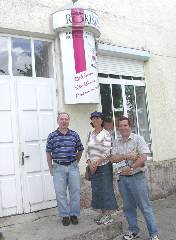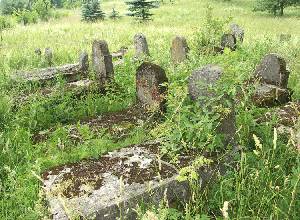
Shapiro Visit to Rokiskis |
||||||
|
Rokiskis SIG member Philip Shapiro visited Rokiskis in 2007 with his brother David and sister Judy Auerbach . Their visit was written up in the local newspaper, Gimtasis Rokiskis, in two articles.. The translations appear below as well as the original Lithuanian text. |
||||||
|
Gimtasis Rokiskis, June 20, 2007,
|
|
|
|
Philip
S. Shapiro (first from left
to right), Judy M. Auerbach
and David B. Shapiro loved
the sight of Nepriklausomybės aikštė (Independence Square),
its cleanliness, and sincerity of Rokiškis residents. Photo
by Šarkaitė |
The
Rokiškis Region Museum and the newspaper Gimtasis
Rokiškis had unexpected visitors of Jewish origin from the U.S.A. and
Israel. Decendants from Jewish families whose ancestors originated from Rokiškis
area were fascinated by great changes in our town and encouraged us to
advertise Rokiskis more in order to attract more tourists of Jewish origin.
The two brothers (both of them are lawyers) Philip S. Shapiro from Virginia and David B. Shapiro from Maryland are visiting Rokiškis for the second time. Their first visit was 10 years ago. The goal of their visit is to see their ancestors‘ land – Kamajai -- once again, find their family roots, and make a family tree. Their sister Judy M. Auerbach, who lives in Israel and works as a tour guide for a travel agency, joined the brothers and is visiting Lithuania for the first time.
The guests noticed that Rokiškis has changed a lot during the period from 1997 to 2007 and the people look much happier and friendlier. However, to their mind, Rokiškis is not being advertised on the Internet as it should be, no tourists are being invited to come for visits here. According to P. Shapiro, the majority of residents in Rokiškis before World War II were Jews. Most of them emigrated. “Their children, grandchildren, and great grandchildren as well would certainly love to visit their ancestors‘ land. This would be very beneficial to the business people of the town who sell their services,“ added the guest.
Philip and David Shapiro belong to the BAYL Jewish Community in Baltimore, MD (founded in 1901) on the basis of Jewish emigrants from Lithuania. It is considered to be one of the oldest Jewish communities in the world. At present it unites 3,500 members. All of them appear to be very active as they keep gathering every two months and every five years a big community reunion is held and a special bulletin before this important occasion is published. By the way, the community‘s website contains much information on Rokiškis.
D. Shapiro
told us that the very first Jewish residents of Kamajai, Pandėlys, and
Čelkiai started emigrating in 1896. This wave lasted till 1912. In those
days new emigrants to the U. S. A. used to get together on Sundays and deposit
a contribution of money to the society‘s savings so that they might be able
to buy a one-way ticket to the U. S. A. for their
fellow –countrypeople that were willing to emigrate. The cost of the
ticket then was 20 USD.
Brothers
Shapiro tried to come to Lithuania several times, but the Soviet officials did
not give them permission. The possibility to visit their grandfather‘s
birthplace turned for the better only when Lithuania regained its
independence. Unfortunately, they didn‘t succeed in finding grandfather‘s
house in Kamajai. Luckily, thanks
to the surviving records in the archives and the records of
land and property describtions, they were able to trace the exact
location his residence.
The guests are also going to visit Pandėlys, Kupiškis, and Pasvalys as a very large number of Jews emigrated from these particular areas.
[Translation By Aldona Sudeikienė]
![]()
Žydų
išeivių palikuonys ragina daugiau reklamuoti Rokiškį
|
|
|
Philipui
S. Shapiro (pirmas iš kairės), Judy M. Auerbach ir Davidui B.
Shapiro labai patiko Nepriklausomybės aikštė, jos švara ir
rokiškėnų nuoširdumas. K.Šarkaitės nuotr. |
Rokiškio krašto muziejus ir Gimtasis... sulaukė netikėtų svečių iš JAV ir Izraelio. Žydų tautybės svečiai, kurių protėviai kilę iš Rokiškio rajono, pasidžiaugė didelėmis permainomis mūsų mieste ir paragino labiau reklamuoti Rokiškį, pritraukti daugiau žydų kilmės turistų.
Broliai advokatai Philipas S. ir Davidas B. Shapiro iš JAV Baltimorės į Rokiškio rajoną atvyko jau antrą kartą. Pirmąkart jie čia viešėjo prieš 10 metų. Vizito tikslas - dar kartą aplankyti protėvių gimtinę – Kamajus, surasti giminės šaknis, sudaryti genealoginį medį. Kartu su broliai spirmą kartą į Rokiškį atvyko Izraelyje gyvenanti sesuo, turizmo agentūros atstovė Judy M. Auerbach.
Svečiai pastebėjo, kad per dešimtmetį Rokiškis labai išgražėjo, o žmonės tapo gerokai laimingesni, draugiškesni. Tačiau, jų manymu, Rokiškis dar labai mažai reklamuojamas internete, nekviečiama turistų. Anot P.Shapiro, iki Antrojo pasaulinio karo daugumą miesto gyventojų sudarė žydų tautybės žmonės. Ne vienas jų emigravo. “Jų vaikai, anūkai, proanūkiai tikrai norėtų apsilankyti protėvių žemėje. Tai būtų nauda miesto verslininkams, parduodantiems savo paslaugas”, - pridūrė svečias.
P. ir D.Shapiro priklauso Baltimorės išeivių žydų seniausiai bendruomenei “BAYL”. Ji buvo įkurta 1 tūkst. 901 išeivių iš Lietuvos pagrindu. Dabar bendruomenė vienija 3 tūkst. 500 narių. Visi labai aktyvūs, renkasi kas du mėnesius, o kas penkerius metus išleidžiami specialūs biuleteniai. Beje, bendruomenės tinklalapyje pateikiama daug informacijos apie Rokiškį.
D.Shapiro papasakojo, kad pirmieji žydų tautos atstovai iš Kamajų, Pandėlio ir Čelkių į JAV pradėjo emigruoti 1896 metais. Ši banga tęsėsi iki 1912-ųjų. Tuo metu į JAV atvykę išeiviai kas sekmadienį susirinkdavo ir papildydavo bendruomenės kasą, kad į JAV norintiems atvykti kraštiečiams galėtų nupirkti bilietus. Bilietas tuomet kainavo 20 dolerių.
Broliai Shapiro atvykti į Lietuvą bandė kelis kartus, bet sovietų valdžia neleido. Galimybė pamatyti senelio gimtinę atsirado tik tuomet, kai Lietuva atgavo Nepriklausomybę. Surasti senelio namo Kamajuose jiems nepavyko. Tačiau pagal archyvuose išlikusius turėtų žemių aprašus pavyko nustatyti gyvenamąją vietovę.
Svečiai taip pat vyks į Pandėlį, Kupiškį, Pasvalį, iš šių vietovių taip pat emigravo labai daug žydų tautybės žmonių.
Audronė
BALTUŠKAITĖ
![]()
Gimtasis
Rokiskis,
June 22, 2007
|
|
|
| The
guests were shocked by what they saw at the old Jewish cemetery. Photo
by K. Šarkaitė |
The sight of the old Jewish cemetery in the village of Serapiniškes [on the western edge of Rokiskis] embittered the Jewish guests‘ stay in our town on the last day of their visit. The grass has not been cut there for a considerably long time and it appeared more like a fallowed pasture. The officials from the Rokiskis town municipality offered various excuses, such as weather conditions that have been very favorable for the growth of vegetation and a shortage of available workers.
The cemetery looked like an overgrown pasture
Gimtasis
Rokiškis wrote about this week‘s visit in our town by the
brothers Philip S. Shapiro and David B. Shapiro from the U. S. A. and
their sister Judy M. Auerbach from Israel. They have a
strong sentimental tie to this area due to the fact that their family
roots are here.
As this was the second visit by the Shapiro brothers to their ancestors‘ land, they expressed their delight about the reconstruction and modernization that they witnessed in the Rokiškis area and the whole Lithuania and were full of nice compliments. When they paid a visit to the editor‘s office on Tuesday, even when the journalists asked them to express any impressions that might not be positive, the guests only emphasized what had impressed them most favorably.
Unfortunately, on Wednesday everything changed for the worse
Since
the guests are interested in their family roots, they decided to visit
the old Jewish cemetery. They were shocked by what they saw there.
„We never expected a sight as bad as this one. We are simply
shocked, overwhelmed by such a disrespect to the past,“ David
couldn‘t hide his displeasure and indignation. “The ramshackle and
fallen monuments are only half of the problem... The perimeter fence
is in very poor condition. The grass on the grounds are quite
overgrown -- it reaches up to your waist -- it‘s just a
jungle…”
According to David B. Shapiro, such disrespect to the dead and the past was quite shocking. David, who happens to visit many parts of the world, claimed that even countries that are quite poor in comparison to Lithuania nonetheless find some means for taking care of cemeteries. „We are not talking about money, but about respect to our ancestors. It doesn‘t matter what religion or nationality they are,“ he added.
[Translation By Aldona Sudeikienė]
![]()
Kapinių
„vaizdzialis“ šokiravo svečius
Paskutinę
viešnagės dieną mūsų mieste žydų tautybės
svečiams apkartino vaizdas, kurį jie išvydo senosiose žydų
kapinaitėse Serapiniškio kaime. Dėl seniai nešienauto
ganyklą primenančio vaizdo savivaldybės valdininkai
teisinasi žolei vešėti itin palankiomis oro sąlygomis bei
darbininkų stygiumi. Kapinės
– kaip nešienauta ganykla Gimtasis...
jau rašė, kad šią savaitę mūsų krašte lankėsi
svečiai iš JAV broliai Philipas S. ir Davidas B. Shapiro bei
Izraelyje gyvenanti jų sesuo Judy M.Auerbach. Mat jų giminės
šaknys – šiuose kraštuose. Antrą
kartą lankydamiesi protėvių žemėje broliai
Shapiro buvo sužavėti Rokiškio krašte ir visoje Lietuvoje
vykstančiomis permainomis, negailėjo gražių žodžių.
Užsukę į „Gimtojo...“ redakciją antradienį,
net primygtinai „spaudžiami“ žurnalistų išsakyti ne tik
teigiamus įspūdžius, svečiai skėsčiojo
rankomis ir vėl kalbėjo tik apie tai, kas jiems padarė
gerą įspūdį. Deja,
trečiadienį viskas apsivertė aukštyn kojomis. Itin
daug dėmesio giminės šaknims skiriantys svečiai sumanė
užsukti į senąsias žydų kapinaites. Tai, ką jie
ten išvydo, sukėlė šoką. „Tokios prastos situacijos
tikrai nesitikėjome. Esame tiesiog pritrenkti, šokiruoti tokios
nepagarbos praeičiai, - neslėpdamas apmaudo ir pasipiktinimo
kalbėjo Davidas. – Aptrūniję ir išvirtę (ar išvartyti)
paminklai – dar pusė bėdos... Tvoros vietą žymi tik
keli kuoliukai. Nepjauta žolė siekia juosmenį – tiesiog
šabakštynas...“ Pasak
Davido B. Shapiro tokia nepagarba mirusiesiems, praeičiai mažų
mažiausiai stebina. Daugybėje pasaulio valstybių lankęsis
Davidas teigė, jog ir gerokai skurdesnėse šalyse nei
Lietuva randama lėšų kapinių priežiūrai. „Pagaliau
kalbame juk ne apie pinigus, o pagarbą protėviams. Ir
nesvarbu, kokio jie tikėjimo ar tautybės“, - sakė jis.
Daugiau
šeštadienio GR |

